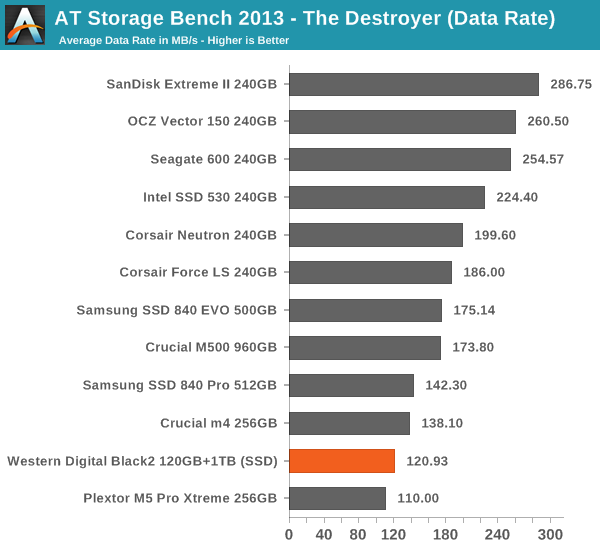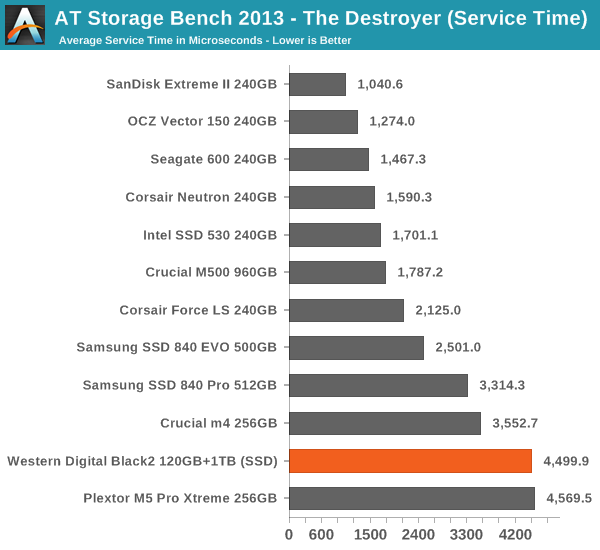The WD Black2 Review: World's First 2.5" Dual-Drive
by Kristian Vättö on January 30, 2014 7:00 AM ESTAnandTech Storage Bench 2013
Our Storage Bench 2013 focuses on worst-case multitasking and IO consistency. Similar to our earlier Storage Benches, the test is still application trace based -- we record all IO requests made to a test system and play them back on the drive we're testing and run statistical analysis on the drive's responses. There are 49.8 million IO operations in total with 1583.0GB of reads and 875.6GB of writes.
As some of you have asked, I'm not including the full description of the test for better readability, so make sure to read our Storage Bench 2013 introduction for the full details.
| AnandTech Storage Bench 2013 - The Destroyer | ||||||||||||
| Workload | Description | Applications Used | ||||||||||
| Photo Sync/Editing | Import images, edit, export | Adobe Photoshop CS6, Adobe Lightroom 4, Dropbox | ||||||||||
| Gaming | Download/install games, play games | Steam, Deus Ex, Skyrim, Starcraft 2, BioShock Infinite | ||||||||||
| Virtualization | Run/manage VM, use general apps inside VM | VirtualBox | ||||||||||
| General Productivity | Browse the web, manage local email, copy files, encrypt/decrypt files, backup system, download content, virus/malware scan | Chrome, IE10, Outlook, Windows 8, AxCrypt, uTorrent, AdAware | ||||||||||
| Video Playback | Copy and watch movies | Windows 8 | ||||||||||
| Application Development | Compile projects, check out code, download code samples | Visual Studio 2012 | ||||||||||
We are reporting two primary metrics with the Destroyer: average data rate in MB/s and average service time in microseconds. The former gives you an idea of the throughput of the drive during the time that it was running the Destroyer workload. This can be a very good indication of overall performance. What average data rate doesn't do a good job of is taking into account response time of very bursty (read: high queue depth) IO. By reporting average service time we heavily weigh latency for queued IOs. You'll note that this is a metric we've been reporting in our enterprise benchmarks for a while now. With the client tests maturing, the time was right for a little convergence.

Our Storage Bench 2013 favors 480GB and bigger drives due to its focus on steady-state performance. Having more NAND helps with worst case performance as ultimately steady-state performance is dictated by the speed of the read-modify-write cycle, which depends on the program and erase times of the NAND. The more NAND the drive has, the higher the probability that there is at least some empty blocks available.
When taking the lower capacity into account, the Black2 isn't terrible but it's not great either. There are some 256GB drives that perform similarly, although it should be noted that the Black2 has 12% over-provisioning instead of 7%, giving it a slight advantage there (the drives are filled with sequential data before the test after all).











100 Comments
View All Comments
Shadowmaster625 - Thursday, January 30, 2014 - link
What a joke. For $300 you can just buy a 512GB SSD and not have to deal with a 2nd partition that might just decide to disappear at any moment due to its odd driver dependency. There's actually one on sale right now for $260. What is WD smoking?LauRoman - Thursday, January 30, 2014 - link
As i understand it it is not a weird driver dependency. The driver is really only needed to flip a switch that woun't suddenly flip back by itself, even if you destroy the drive's mbr/gpt. It should work in any os after the switch is flipped. I don't know if you need a Windows install to switch it on though.Panzerknacker - Thursday, January 30, 2014 - link
Exactly, that's what I'm thinking as well, the driver is only used to flip a certain switch that's unique in this particular drive. Now that I'm thinking of it they probably did this to help with installing Windows. When installing Windows the installer will only find the 120gb partition, Windows has the strange behaviour of messing around with partitions during installation and putting system stuff on other partitions. Normally you can disconnect the other drives in the system, not on this one ofc because it's 2 in 1. Then when everything is installed you can enable the other partition with the switch triggered by the driver.I'd wonder how you would do this without Windows tho, they should also include a hardware switch.
mikato - Friday, January 31, 2014 - link
I HATE that. Detaching everything but the SSD is standard procedure during Windows installation now because of that. It's a nasty surprise when you decided to take out your hard drive or switch it with another only to find that Windows won't boot now, even when you had installed Windows on the SSD! Do you know if Windows 8 does this?HisDivineOrder - Thursday, January 30, 2014 - link
It's been a long time since WD truly impressed me with a new product.Guspaz - Thursday, January 30, 2014 - link
I've seen the 1TB Samsung 840 EVO go under $500. If you gave me the choice between paying $300 for a slow 1TB HDD with a pretty terrible 120GB SSD, or paying $500 for a fast 1TB SSD, which do you think I'd pick?About the only thing that could make the WD solution interesting is if it offered a substantially more attractive price than the SSD (and "somewhat cheaper" isn't), and if it had the SSD caching solution in hardware so that it could just be plugged in and used as a normal drive.
With a full 1TB SSD costing not much more than this thing, it's not useful for the "notebook with only one 2.5" slot" scenario... or any other scenario.
coolhund - Sunday, February 9, 2014 - link
Exactly. Also keep in mind that SSD prices keep falling and falling, while HDDs still havent gotten back to the prices that we had before that 'flood' and are not really getting cheaper nowadays. And thats why it will fail, just like the hybrid ones. I think it will actually fail even more.mobutu - Thursday, January 30, 2014 - link
Too little, Too lateI mean with very good 1TB SSDs ready to go mainstream at 400-500USD this wd2 is completely useless, especially for all the people that already use SSDs and know what a tremendous impact it has over a hdd dinosaur (performance/power/heat/silence/formfactor) (msata at 1TB already gimme a break must be a joke to look at wd2).
HDDs are close to extinct, it is a matter of time/price until they'll dissapear completely exactly like the FDD ... both are/were huge bottleneck to a system.
chizow - Thursday, January 30, 2014 - link
I thought this was pretty useless when it was announced a few months ago, but with the increasing popularity of SFF and NUC-like devices, this drive would be perfect.Gigaplex - Thursday, January 30, 2014 - link
Or you could just get a 1TB SSD, this drive isn't that much cheaper.